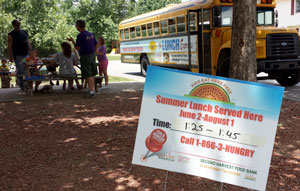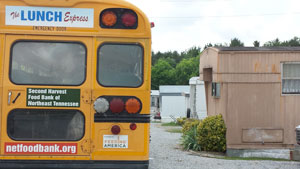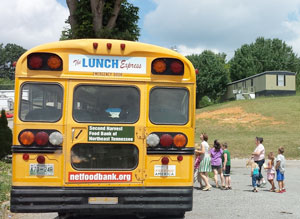Lunch Express Summer Food Program
- Need: With school lunch programs inactive during summer months, rural children in Northeast Tennessee experienced food insecurity.
- Intervention: Second Harvest Food Bank of Northeast Tennessee used repurposed school buses to expand meal delivery to rural children in remote areas of eight counties.
- Results: During summer months, four converted school buses bring meals to nearly 350 children, traveling 11,000 miles in rural and remote areas. In toto, the organization reaches nearly 6,000 school children with food insecurity.
Description
 According to the Food Research
and Action Center's
2016 Summer Nutrition Status Report, only 1 in 6 of
the nation's children in school lunch programs
participated in summer food programs during 2014-2015.
The
Center's 2020 report revealed that in July 2019, for
every 100 low-income children who participated in the
school year lunch program, only about 14 children
received a summer lunch.
According to the Food Research
and Action Center's
2016 Summer Nutrition Status Report, only 1 in 6 of
the nation's children in school lunch programs
participated in summer food programs during 2014-2015.
The
Center's 2020 report revealed that in July 2019, for
every 100 low-income children who participated in the
school year lunch program, only about 14 children
received a summer lunch.
To address these summer food security issues in their own region, Second Harvest Food Bank of Northeast Tennessee has spent now over a decade slowly expanding their outreach to children in rural and remote areas. As an affiliate of the Feeding America Network of Food Banks, the nation's largest foodbank network, Second Harvest, Kingsport, is the only food bank serving the eight county region, now reaching nearly 4300 children.
Second Harvest began its food service mission in 1986. With time, the food bank's outreach grew, taking on the food security issues of children with programs such as Backpack Lunch. Calls from concerned rural teachers brought further focus to food security issues in the more rural and remote areas of their region. Acknowledging that rural food service programs were difficult due to distance and transportation issues, Second Harvest embraced the challenge and expanded their food security mission. In 2012, the conversion of 4 school buses into food delivery vehicles made a rural and remote reach to children possible.
Route Planning
Initial route planning included reviewing free/reduced
lunch data at local school level and census block data
because Second Harvest's mobile programs reach areas
other efforts can't, especially when accommodating
congregant consumption guidelines. These guidelines
for meal reimbursement are especially difficult to meet
when homes are 20 miles apart.
Road conditions were also considered with route planning since communities and homes in the Tennessee hollows and mountains challenge mechanical capabilities of school buses constructed for flatlands. Instead vans sometimes must be used.
Second Harvest's key to reaching rural children is coordinating with the communities served. Community members and the bus drivers know where young populations concentrate and suggested stops at town outskirts, multi-family housing and apartment units, and mobile home parks. Firehouses, churches, picnic grounds, or even a cool, shaded area outside a cemetery are all examples of food stops. Recent partnerships with mobile libraries provided additional stops.
Mobile Food Program Infrastructure
Building on another partner organization's converted
school bus idea, Second Harvest used various grants to
purchase and modify vehicles. A few back seats are
removed to allow cool storage meals, remaining seats
allow children to eat on the bus.
 Fourteen staff are needed to run the
program. For each bus, 1 local bus driver with commercial
license and 1 or 2 AmeriCorps members are required. A
third assistant is present for routes serving more than
100 children. Staffing totals for the summer of 2017
included 4 bus drivers and 22 AmeriCorps members. All
staff undergo national background checks, complete civil
rights training, and other program-specific educational
sessions.
Fourteen staff are needed to run the
program. For each bus, 1 local bus driver with commercial
license and 1 or 2 AmeriCorps members are required. A
third assistant is present for routes serving more than
100 children. Staffing totals for the summer of 2017
included 4 bus drivers and 22 AmeriCorps members. All
staff undergo national background checks, complete civil
rights training, and other program-specific educational
sessions.
Meals are reimbursed at a rate set by the USDA each summer and costs exceeding the reimbursement funds are covered through grants and private donations. Funding and financial sustainability comes mainly from grants, along with business and individual donations. For example, Tennessee meals were reimbursed through the Department of Human Services; Feeding America offered summer grants sponsored by ConAgra; the Laughlin Foundation hosted a private fundraiser for their counties summer program; and Share Our Strength provided mini-grant opportunities through the Arby's Hometown Hero grant Summer 2017.
COVID-19 Pandemic Efforts
With the declaration of the public health emergency due to COVID-19 in early 2020, schools continued to run bus routes with meal delivery. The organization's staffing model was impacted since no volunteers were allowed on site to make meals. Adapting to emergency needs, the organization pivoted with CARES Act food relief funding to create monthly mobile food pantries that stopped in the majority of its service area school systems. For the few stationary sites that reopened, a hospital kitchen was able to make the lunches. Despite COVID-19 limitations, one-half million pounds of food were delivered to over 6,000 children and their families.
Because of its existing work the U.S. Department of Agriculture Food and Nutrition Service (USDA-FNS) in the creation of its previous non-congregate meal model with Tennessee's Electronic Benefit Transfer (EBT)program, the food bank participated in pilot work around the Pandemic Electronic Benefit Transfer (P-EBT) program, a program that aimed at "providing more money for low-income families and millions of children missing meals due to school and child care closures."
As of April 2021, the organization will continue its mobile food pantries. It is also working with local health departments creating policies and procedures in order to restart congregate meal service in subsequent months.
Funding Support
Private funds are especially helpful in order to reach the most remote areas not qualifying under congregate eating guidelines.
Strategic local partners are: Share Our Strength, The Laughlin Foundation, AmeriCorps, Feeding America, School Nutritionists. Family Resource Centers and food bank agency partners share space and host sites.
The program has been the recipient of several awards, including special State of Tennessee awards in 2015 and 2016.
Services offered
 Meals are organized by Second Harvest's
Summer Food Service Coordinator and follow USDA
guidelines for
Summer Food Service Program (SFSP) program and the
Child and Adult
Care Food Program (CACFP).
Meals are organized by Second Harvest's
Summer Food Service Coordinator and follow USDA
guidelines for
Summer Food Service Program (SFSP) program and the
Child and Adult
Care Food Program (CACFP).
Meals include shelf-stable meal packs, thaw-and-serve meal packs, and even brown bag lunches. All meals follow USDA guidelines. Morning packing time takes about 90 minutes. Coolers are packed according to established guidelines so temperatures are 40 degrees or less at all times. Cooler temps are checked at every stop. Buses leave around mid-morning and routes are completed by late afternoon. Each bus makes 8 to 10 stops, and spends about 20 minutes at each site. A minimum of five children per stop sustains the stop.
In 2019, the organization added two new services: added vans to do smaller county routes and, in collaboration with the United Way, piloted a reading program.
Results
In 2009, Second Harvest's first food security program effort reached 55 children and served over 700 meals. With the addition of the converted buses in 2012, the mobile units now reach 36 sites. With a total of 64 mobile and stationary sites, as of 2016, the organization's summer months' outreach has served 40,000 meals to nearly 3600 children.
For the area's rural and remote children, the 4 converted school buses travel approximately 11,000 miles every summer and serve nearly 6700 meals to 350 children.
Early 2018 data demonstrates that over 11,000 children received the Summer EBT benefit to buy groceries in some of the most rural counties the organization serves. Each qualified child received $30 a month for up to 3 months in a special SNAP benefit. Using the SNAP model as opposed to the WIC model, families could choose how the extra benefit was use and we encouraged them to "double their bucks" at participating farmer's markets in order to purchase fresh fruits and vegetables.
Additional benefits are the formative relationships between the food bank's staff and parents and children served.
Again — despite COVID-19 limitations — in 2020, one-half million pounds of food were delivered to over 6,000 children and their families.
Challenges
- Meeting congregate feeding requirements
- Preplanning meal types
- Preplanning loading areas
- Purchasing and maintaining buses
- Staff salaries for mobile outreach
- Finding sites with enough numbers to make route practical and service sustainable
- Staffing
- Engaging community partners
Replication
Any replication effort must be grounded in this mission and vision: impacting an area's childhood food security mitigates the challenges of expense and logistics. Additional considerations are:
- Start small and expand slowly
- Use of pilot programs are crucial
- Establish strategic community partnerships with organizations of like-mission and values
- Streamline and simplify meal preparation
- Following specific packing protocol for freezer packs and coolers to maintain temperatures 40 degrees or less
- Promoting flexible attitudes is a must, with "back-up plans" for the "back-up plans"
- Equipment flexibility is also required: for example, vans are able to reach areas buses can't.
- Advanced planning with maps for routes
- Advanced planning to work with roadside assistance organizations, especially those able to service emergency bus tire issues
- Engage community members and bus drivers with familiarity of routes/communities to maximize meal stop outreach
- Provide gas and credit cards to bus drivers for emergency repairs or food supplies.
- Repetitive grant applications to cover expenses not covered by meal reimbursement programs.
Contact Information
Heidi Davis, Summer Feeding CoordinatorSecond Harvest Food Bank of NE Tennessee
423.279.0430 ext 205
summerfeeding@netfoodbank.org
Topics
Children and youth
Food security and nutrition
States served
Tennessee
Date added
August 22, 2017
Date updated or reviewed
April 6, 2021
Suggested citation: Rural Health Information Hub, 2021. Lunch Express Summer Food Program [online]. Rural Health Information Hub. Available at: https://www.ruralhealthinfo.org/project-examples/974 [Accessed 23 April 2024]
Please contact the models and innovations contact directly for the most complete and current information about this program. Summaries of models and innovations are provided by RHIhub for your convenience. The programs described are not endorsed by RHIhub or by the Federal Office of Rural Health Policy. Each rural community should consider whether a particular project or approach is a good match for their community’s needs and capacity. While it is sometimes possible to adapt program components to match your resources, keep in mind that changes to the program design may impact results.
